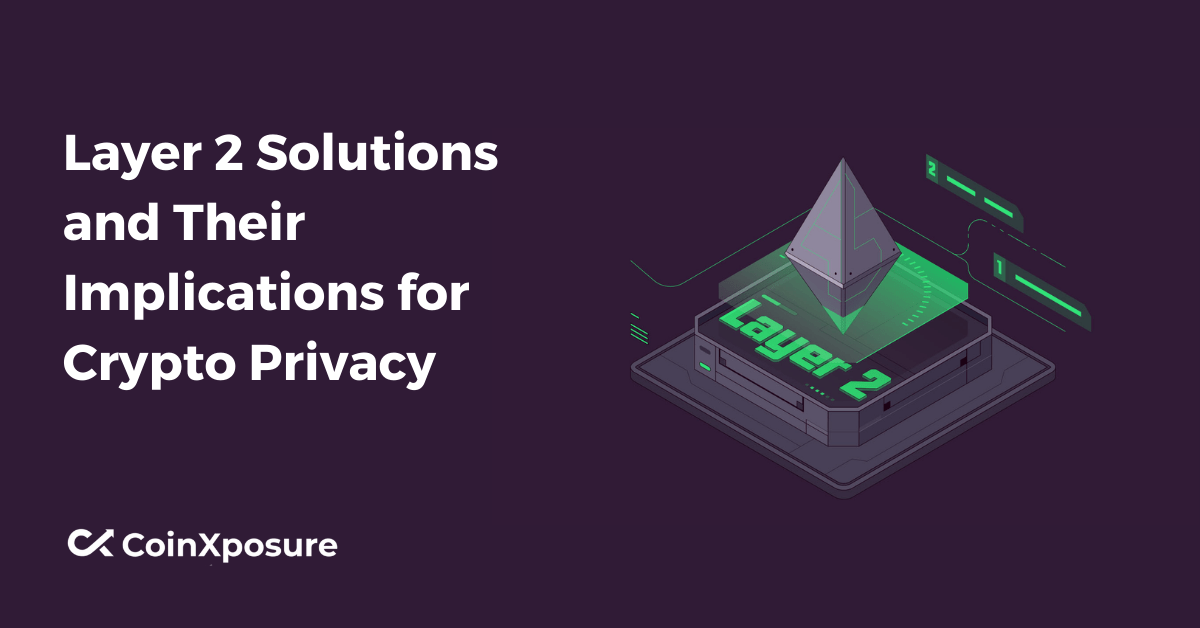
Layer 2 Solutions and Their Implications for Crypto Privacy
Layer 2 solutions emerged to address cryptocurrency difficulties, giving crypto fans the tools they need to navigate the complex world of blockchain technology.
This article discusses layer 2 solutions and their implications for crypto privacy.
Scalability is an essential issue in Crypto since it impacts how well a blockchain network performs.
Scalability refers to a network’s ability to accommodate a growing volume of transactions while maintaining speed and cost efficiency.
Initially, when blockchain technology was introduced via Bitcoin, the goal was to create a decentralized, secure, and transparent transaction system.
However, as the ecosystem expanded, the lack of scalability in Layer 1 blockchains became apparent, resulting in poor transaction rates and hefty transaction fees. This is where Layer 2 solutions come in handy.
What are Layer 2 Solutions?
Layer-2 solutions are essentially scaling techniques for a Layer-1 protocol (think ETH), resulting in cheaper and faster transactions.
Polygon Technology, Optimism, and Loopring have been prominent Layer-2 solutions in the past, and they are commonly used by users hoping to reduce Ethereum transaction prices and network congestion.
However, most people transact with Polygon through a sidechain (e.g., Sandbox, Decentraland, QuickSwap users) rather than actual Layer 2 solutions.
The major distinction between a sidechain and Layer 2 solutions is that bridge contracts on sidechains presume that transactions completed on the sidechain are valid.
Still, bridge contracts on Layer 2 solutions can verify transaction legitimacy by ETH standards.
Layer 2 solutions essentially roll many transactions (executed off the main chain) into a single bundle and communicate the bundle’s validity to the L1 protocol.
This drastically reduces the amount of transactions the network must handle.
Although most Layer 2 solutions function by outsourcing transaction execution from the main chain (Ethereum), their implementation varies; they are Zero Knowledge Rollups, Optimistic Rollups, and Validium/Plasma.
The primary distinction between Rollups and Validium/Plasma is that the latter offloads data availability (in addition to transaction execution) from the underlying L1 platform.
While this is useful for protecting data privacy, the data stored off-chain lacks the same security architecture as the underlying L1 protocol, which might cause problems if the data goes offline.
Next, let’s see some examples of layer 2 solutions.
Techniques of Layer 2 Solutions
Here are some key techniques of Player 2 solutions.
- Sidechains
- State channels
- Optimistic Rollups
- Zero-Knowledge Rollups
Sidechains
Sidechains are separate blockchains linked to the main chain, allowing specific assets to be transferred between them.
This allows multiple blockchains to communicate and exchange assets, increasing interoperability between blockchain networks.
The disadvantage of sidechains is that the main Layer 1 chain does not protect them. Thus, they must pay for their security using a consensus process such as Proof-of-Stake (POS) or Proof-of-Work.
One example is the Liquid Network, a sidechain to the Bitcoin blockchain. The Liquid Network allows users to identify BTC as “Liquid BTC (LBTC).”
This can lead to increased liquidity, faster, cheaper transactions, and the ability to specify additional assets on the network.
Examples of Ethereum sidechains include Polygon PoS and XDai/Gnosis. Developers can get accessible endpoints for Polygon and XDai/Gnosis here.
State Channels
State channels are also part of the Layer 2 solutions. They enable two or more parties to conduct multiple transactions off-chain without broadcasting each transaction to the whole network.
This can dramatically increase a blockchain’s scalability by reducing the transactions the network must process and lowering costs (see table below).
The Lightning Network, a Layer 2 protocol that runs on the Bitcoin blockchain, is one example of how state channels are used.
The Lightning Network enables users to conduct multiple transactions off-chain, eliminating the need to broadcast each transaction to the whole network.
This significantly enhances the scalability of the Bitcoin blockchain, enables rapid settlement, and lowers transaction fees.
Optimistic Rollups
Optimistic Rollups are Layer 2 solutions for Ethereum that enable users to execute smart contracts off-chain, eliminating the requirement for each transaction to be broadcast over the network.
This increases the scalability of the Ethereum blockchain and lowers transaction fees (see table below).
Optimistic Rollups are protected by Ethereum Layer 1, as all transactions eventually settle on Ethereum.
However, the disadvantage is that these Rollups “optimistically” assume that transactions are genuine and impose a seven-day verification challenge before withdrawing cash to the Ethereum main chain.
Rollups include Arbitrum and Optimism. Both are EVM (Ethereum Virtual Machine) compatible. Therefore, the Ethereum code may be simply moved across.
If you wish to test either one, you can acquire an accessible Optimism or an Arbitrum endpoint.
Optimism announced the OP Stack on top of Optimism in late 2022, allowing developers to build blockchains and new experimental use cases from scratch.
It lets its users create OP Craft (Minecraft on top of Optimism, a fully on-chain voxel environment) and could also allow Rollups to settle using Bitcoin.
Arbitrum followed suit, creating Arbitrum Nova, a new blockchain providing reduced transaction fees and more significant transaction volumes.
As more Ethereum transactions are handled via rollups, consumers should expect fee reductions of 10-100 times. That all rests on EIP 4844, a proposal that isn’t expected to be enacted until late 2023.
Zero-Knowledge Rollups (Z-K Rollups)
Zero-knowledge rollups use Zero Knowledge Proofs (ZK-proofs) to validate up to thousands of transactions in a batch before posting minimal summary data to the main chain.
A Zero Knowledge Proof enables one person (the prover) to demonstrate to another (the verifier) that a statement is true without disclosing any information about the assertion.
This can increase blockchain privacy by allowing transactions to be confirmed without revealing sensitive transaction details.
Zero Knowledge Proof technology is anticipated to be a crucial component in developing enterprise use cases that will enable users to show only the information they desire to third parties while securely delivering critical data.
Let’s see the implications of Layer 2 solutions for crypto privacy.
Layer 2 Solutions and Crypto Privacy
To address the constraints of the Ethereum network, the blockchain community is seeing the introduction of new layer 2 solutions that lead to innovations aimed at improving many elements of blockchain functioning, ranging from scalability and speed to crypto privacy.
The competition to develop more on the blockchain has enticed even established layer-1 ecosystems to embrace the convenience of layer 2 solutions.
The previous L1 ecosystem COTI, known for its Web3 payment capabilities, has rebranded as COTI V2, focusing on Ethereum privacy protection.
Sensitive material transferred as public information on a blockchain is a flaw, not a benefit, and it is not accepted in conventional business systems, so why should it be tolerated on the blockchain?
COTI V2 will prevent sensitive data from being broadcast to competitors, partners, and clients, allowing organizations to leverage blockchain’s many benefits and access Web3 in a purpose-built environment optimized for speed, scalability, and performance.
With that, let us see some challenges this technology has faced.
Challenges of Layer 2 Solutions
While Layer 2 solutions have tremendous potential to improve scalability, increase privacy, and reduce fees in the cryptocurrency realm, they are not without hurdles and restrictions.
- One of the most significant issues is interoperability, as different Layer 2 solutions may need to be compatible, reducing their total effectiveness.
- The security of Layer 2 solutions can also be an issue, as any flaws or assaults on the bottom layer could affect all connected layers.
- Another barrier is the level of complexity required to implement Layer-2 solutions. The integration process can be time-consuming and resource-intensive, necessitating developers to understand the technology’s complexities properly. Maintaining consensus across numerous layers can be difficult, as each layer may have its governance system.
- Also, while Layer-2 solutions significantly improve scalability, they may have transaction throughput and financial constraints. Depending on the approach, scalability and decentralization may be traded off.
Developers and stakeholders must work together as technology advances to overcome these difficulties and ensure the widespread adoption and success of Layer-2 solutions in the crypto industry.
Future Outlook For Layer 2 Solutions
As the cryptocurrency ecosystem evolves, Layer 2 solutions are expected to encourage innovation and acceptance significantly.
The technology has already proved its capacity to improve scalability and reduce the costs associated with blockchain transactions. Layer 2 solutions have a promising future as more initiatives are developed.
Metaworld, in particular, is primed to emerge as a significant competitor in the Layer-2 arena.
Metaworld’s novel method of constructing virtual worlds with blockchain technology addresses the difficulties of scalability, interoperability, and security in a new way.
Its Layer 2 solutions enable faster, more efficient transactions to manage higher transaction volumes.
Final Thoughts
Blockchain Layer 2 solutions are essential in improving the underlying blockchain’s scalability, privacy, and other properties, making it more efficient and cost-effective for consumers.
That is why this field is expanding and altering so rapidly. Layer 2 solutions will become increasingly essential as blockchain addresses business difficulties across various industries.





